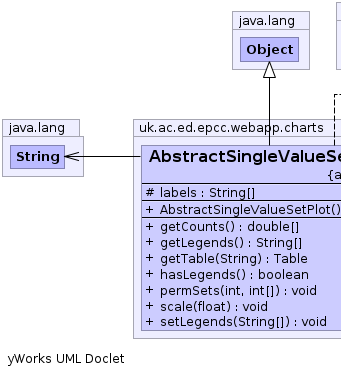- java.lang.Object
-
- uk.ac.ed.epcc.webapp.charts.AbstractSingleValueSetPlot
-
- All Implemented Interfaces:
- Plot, SetPlot, SingleValueSetPlot
- Direct Known Subclasses:
- AbstractPeriodSetPlot
public abstract class AbstractSingleValueSetPlot extends java.lang.Object implements SingleValueSetPlot
This is a abstract superclass forSingleValueSetPlotthat implements the methods fromSetPlotvia the additional methods inSingleValueSetPlot.
-
-
Field Summary
Fields Modifier and Type Field and Description protected java.lang.String[]labels
-
Constructor Summary
Constructors Constructor and Description AbstractSingleValueSetPlot()
-
Method Summary
All Methods Instance Methods Concrete Methods Modifier and Type Method and Description double[]getCounts()sum the contents of the dataset returning an array by setjava.lang.String[]getLegends()get the legend stringsTablegetTable(java.lang.String quantity)Create a table representing the data in thisSetPlot.booleanhasLegends()voidpermSets(int new_nset, int[] perm)permute the contents of the sets in a Dataset labels are also permuted/truncated.voidscale(float scale)rescale all the data by a factorvoidsetLegends(java.lang.String[] leg)set the legends strings These are the labels for the different sets in thisSetPlot-
Methods inherited from class java.lang.Object
clone, equals, finalize, getClass, hashCode, notify, notifyAll, toString, wait, wait, wait
-
Methods inherited from interface uk.ac.ed.epcc.webapp.charts.SingleValueSetPlot
add, get, set
-
Methods inherited from interface uk.ac.ed.epcc.webapp.charts.SetPlot
getNumSets, setNumSets
-
-
-
-
Method Detail
-
getTable
public Table getTable(java.lang.String quantity)
Description copied from interface:SetPlotCreate a table representing the data in thisSetPlot. Each set of data produces a row of the table keyed by the corresponding label. The data columns produced are chosen by the implementing class subject to the advice that multipleSetPlots that can co-exist in a single chart should also make sense when combined into a single table.
-
permSets
public final void permSets(int new_nset, int[] perm)Description copied from interface:SetPlotpermute the contents of the sets in a Dataset labels are also permuted/truncated.
-
scale
public void scale(float scale)
Description copied from interface:Plotrescale all the data by a factor
-
getCounts
public final double[] getCounts()
Description copied from interface:SetPlotsum the contents of the dataset returning an array by set
-
getLegends
public java.lang.String[] getLegends()
Description copied from interface:SetPlotget the legend strings- Specified by:
getLegendsin interfaceSetPlot- Returns:
- String[] legends
-
setLegends
public void setLegends(java.lang.String[] leg)
Description copied from interface:SetPlotset the legends strings These are the labels for the different sets in thisSetPlot- Specified by:
setLegendsin interfaceSetPlot
-
hasLegends
public boolean hasLegends()
- Specified by:
hasLegendsin interfaceSetPlot
-
-

